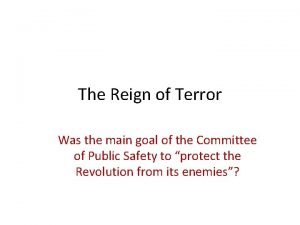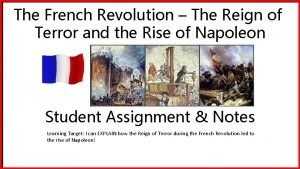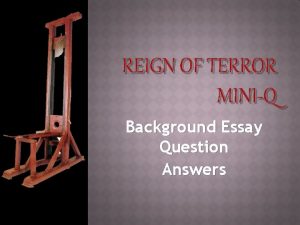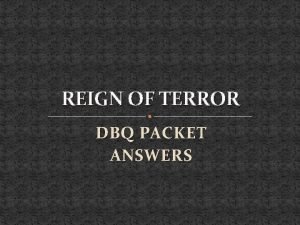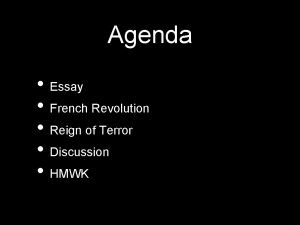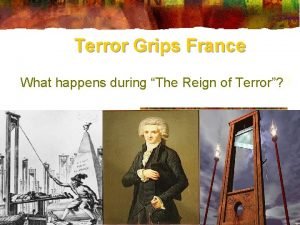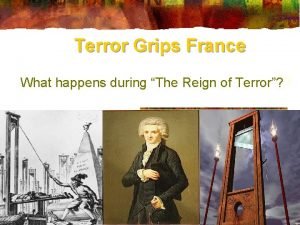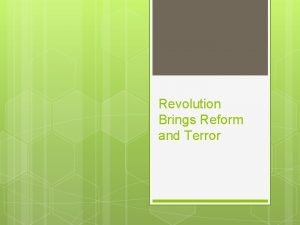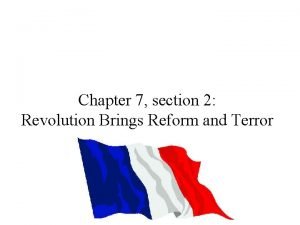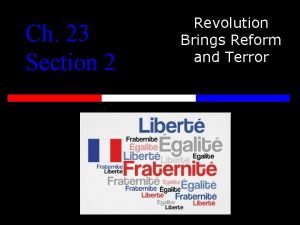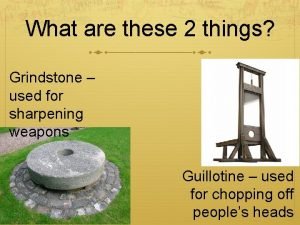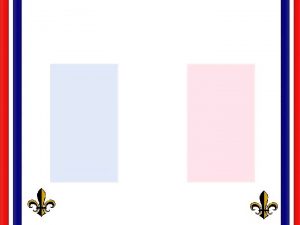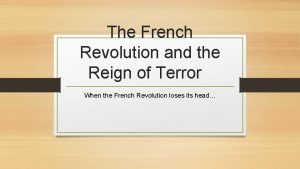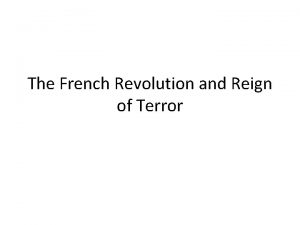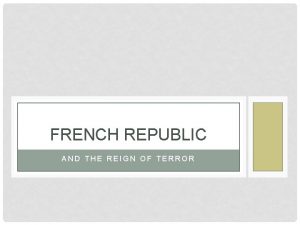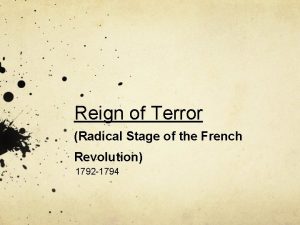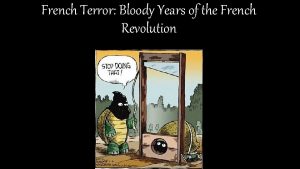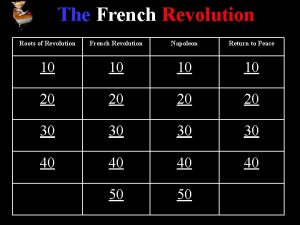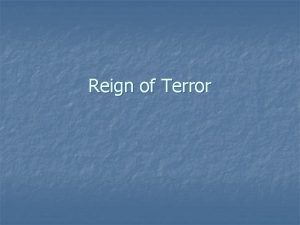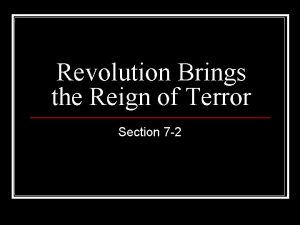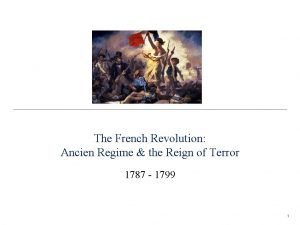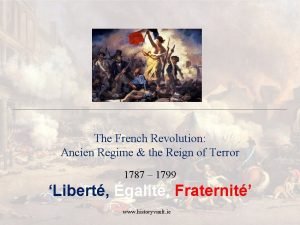The Reign of Terror French Revolution Social Studies





















- Slides: 21

The Reign of Terror French Revolution Social Studies 9 Prince of Wales Secondary Ms. Underwood

Phases of the French Revolution National Assembly (1789 -1791) Legislative Assembly (1791 -1792) Convention (1792 -1795) Directory (1795 -1799)

The National Convention was the new legislative body that replaced the National Assembly. The first act of this new government was to officially remove the King from the French government. France was declared a republic. The National Convention also discarded the traditional Gregorian calendar in favor of a Revolutionary Calendar.

What to do with the King? The radical Jacobins demanded that Louis XVI be tried for treason. The Girondins were moderate and would have been satisfied had Louis been exiled. vs. Exile?

Two Radical Groups During the constitutional monarchy there were two radical groups vying for power, the Girondins and the Jacobins. Although both groups were more radical in their views than the moderates who had designed the constitutional monarchy, the Girondins were somewhat less radical. In late 1791, the Girondins first emerged as an important power in France.

The Girondins A political group in France within the Legislative Assembly and the National Convention. Supported the revolution to start, but then became fearful that it was spiraling out of control. Came into conflict with a radical faction of the Jacobin Club, which eventually led to their fall, beginning the Reign of Terror. They were a group of loosely affiliated individuals , rather than an organized political party.

The San-Culottes At the beginning of the revolution, the working men of Paris allowed the revolutionary bourgeoisie to lead them. But by 1790 the sans-culottes were beginning to be politically active in their own right. They were called sans-culottes (literally, without trousers) because the working men wore loose trousers instead of the tight knee breeches of the nobility. Eventually sans culottes came to refer to any revolutionary citizen.

The sans culottes The bourgeoisie

Georges-Jacques Danton Georges-Jacques Danton, a revolutionary leader and a powerful orator, rose in the Assembly on September 2 nd 1792 and boomed out these memorable words in his deep bass voice: "When the tocsin sounds, it will not be a signal of alarm, but the signal to charge against the enemies of our country. . . To defeat them, gentlemen, we need boldness, and again boldness, and always boldness; and France will then be saved. "

Georges-Jacques Danton: "Boldness and again boldness, and always boldness"

Let the blood of the traitors flow Danton probably meant boldness in fighting the war against Austria. But many took his words to refer to enemies within France. The radical press took up the cry, "Let the blood of the traitors flow, " and within hours of Danton's speech the streets of France did indeed run with blood. By September 7, over 1000 were dead.

Jean-Paul Marat When Jean-Paul Marat, a Jacobin journalist who showed little regard for the truth, was arrested for attacking Girondins, the people of Paris turned even more toward the Jacobins. The people loved Marat and he seemed to love them too. When he was acquitted of the charge, the crowds swarmed around him, scooped him up on their shoulders and carried him to the Convention, cheering all the way.

The Rise of the Jacobins When the constitutional monarchy fell and he King was put on trial for treason in December, the Girondins argued against his execution. The Jacobins thought he needed to die to ensure the safety of the revolution. When the Jacobins were successful the tide turned against the Girondins. The Jacobins in the National Convention had 22 Girondin leaders arrested and executed. The Jacobins had won.

The Death of Marat A final Girondin blow was struck, however, when Charlotte Corday, a Girondin sympathizer, gained entrance to Marat's bath and stabbed him. Marat immediately became a martyr to the revolution. He was given a hero's funeral and the procession lasted 7 hours.

The Death of Marat by Jacques-Louis David

The Reign of Terror After the death of Louis in 1793, the Reign of Terror began. The guillotine, the new instrument of egalitarian justice, was put to work. The Revolutionary Tribunal ordered the execution of 2, 400 people in Paris by July 1794. Across France 30, 000 people lost their lives.

Watch Committees The Terror was designed to fight the enemies of the revolution, to prevent counter-revolution from gaining ground. Most of the people rounded up were not aristocrats, but ordinary people. A man (and his family) might go to the guillotine for saying something critical of the revolutionary government. Watch Committees around the nation were encouraged to arrest "suspected persons, . . . those who, either by their conduct or their relationships, by their remarks or by their writing, are shown to be partisans of tyranny and federalism and enemies of liberty" (Law of Suspects, 1793).

Suspension of Civil Liberties Civil liberties were suspended. The Convention ordered that "if material or moral proof exists, independently of the evidence of witnesses, the latter will not be heard, unless this formality should appear necessary, either to discover accomplices or for other important reasons concerning the public interest. " The promises of the Declaration of the Rights of Man were forgotten. Terror was the order of the day. In the words of Maximilien Robespierre, "Softness to traitors will destroy us all. "

Maximilien Robespierre "Terror is nothing other than justice, prompt, severe, inflexible"

Republic of Virtue Robespierre was the mastermind of the Reign of Terror. He was the leader of the Committee of Public Safety, the executive committee of the National Convention, and the most powerful man in France. He explained how terror would lead to the Republic of Virtue in a speech to the National Convention: “If the spring of popular government in time of peace is virtue, the springs of popular government in revolution are at once virtue and terror: virtue, without which terror is fatal; terror, without which virtue is powerless. Terror is nothing other than justice, prompt, severe, inflexible. . . ” Speech on Terror The old maxim "the end justifies the means" describes Robespierre's policy well.

The Last Victim of the Reign of Terror Even the radical Jacobins, the supporters of Robespierre, come to feel that the Terror must be stopped. Danton rose in the Convention calling for an end to the Terror. He was its next victim. When Robespierre called for a new purge in 1794, he seemed to threaten the other members of the Committee of Public Safety. The Jacobins had enough. Cambon rose in the Convention and said “It is time to tell the whole truth. One man alone is paralyzing the will of the Convention. And that man is Robespierre. ” Others quickly rallied to his support. Robespierre was arrested and sent to the guillotine the next day, the last victim of the Reign of Terror.
 What was the main goal of the reign of terror
What was the main goal of the reign of terror Leader of france during the reign of terror
Leader of france during the reign of terror Reign of terror questions and answers
Reign of terror questions and answers Was the reign of terror justified essay
Was the reign of terror justified essay Reign of terror essay
Reign of terror essay What happens during the reign of terror
What happens during the reign of terror Robespierre reign of terror
Robespierre reign of terror The terror grips france
The terror grips france Napoleonic code women
Napoleonic code women The reign of terror was it justified background essay
The reign of terror was it justified background essay Reign of terror dbq answers
Reign of terror dbq answers Russian revolution vs french revolution
Russian revolution vs french revolution Economic causes of french revolution
Economic causes of french revolution Outcome of french revolution
Outcome of french revolution Social causes of french revolution
Social causes of french revolution Revolution brings reform and terror
Revolution brings reform and terror Chapter 7 section 2 revolution brings reform and terror
Chapter 7 section 2 revolution brings reform and terror Chapter 23 section 2 revolution brings reform and terror
Chapter 23 section 2 revolution brings reform and terror Paradigm shift from women studies to gender studies
Paradigm shift from women studies to gender studies Definition of third agricultural revolution
Definition of third agricultural revolution Grindstone french revolution
Grindstone french revolution French revolution causes and effects
French revolution causes and effects
